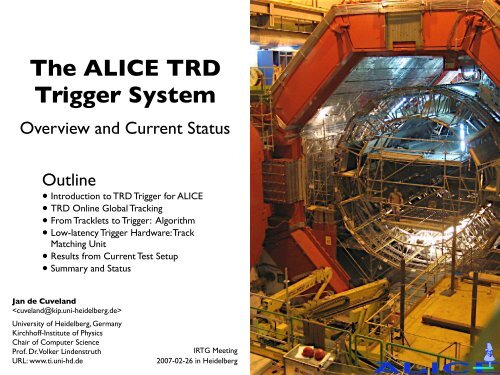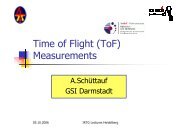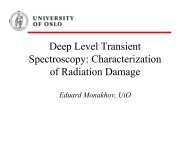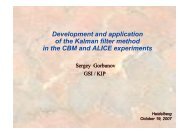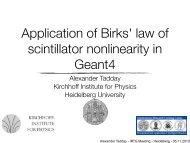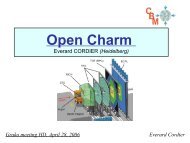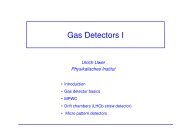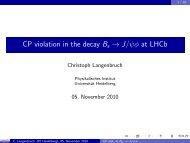The ALICE TRD Trigger System - IRTG Heidelberg
The ALICE TRD Trigger System - IRTG Heidelberg
The ALICE TRD Trigger System - IRTG Heidelberg
You also want an ePaper? Increase the reach of your titles
YUMPU automatically turns print PDFs into web optimized ePapers that Google loves.
<strong>The</strong> <strong>ALICE</strong> <strong>TRD</strong><br />
<strong>Trigger</strong> <strong>System</strong><br />
Overview and Current Status<br />
Outline<br />
• Introduction to <strong>TRD</strong> <strong>Trigger</strong> for <strong>ALICE</strong><br />
• <strong>TRD</strong> Online Global Tracking<br />
• From Tracklets to <strong>Trigger</strong>: Algorithm<br />
• Low-latency <strong>Trigger</strong> Hardware: Track<br />
Matching Unit<br />
• Results from Current Test Setup<br />
• Summary and Status<br />
Jan de Cuveland<br />
<br />
University of <strong>Heidelberg</strong>, Germany<br />
Kirchhoff-Institute of Physics<br />
Chair of Computer Science<br />
Prof. Dr. Volker Lindenstruth<br />
URL: www.ti.uni-hd.de<br />
<strong>IRTG</strong> Meeting<br />
2007-02-26 in <strong>Heidelberg</strong>
<strong>ALICE</strong> Experiment Overview<br />
lead nucleon<br />
~ speed of light<br />
<strong>TRD</strong><br />
interaction point<br />
lead nucleon<br />
~ speed of light<br />
<strong>ALICE</strong><br />
• 1150 TeV Pb-Pb<br />
interactions<br />
• 8000 collisions per<br />
second<br />
• Detectors for<br />
• <strong>Trigger</strong> (diff.<br />
levels): ITS, <strong>TRD</strong><br />
• High resolution<br />
tracking: TPC<br />
Jan de Cuveland – Uni <strong>Heidelberg</strong>, KIP – <strong>The</strong> <strong>ALICE</strong> <strong>TRD</strong> <strong>Trigger</strong> <strong>System</strong> – <strong>IRTG</strong> Meeting, <strong>Heidelberg</strong> – 2007-02-26 2<br />
• ...<br />
Goal is to create the Quark-Gluon<br />
Plasma, a state of matter existing<br />
during the first few microseconds<br />
after the big bang
Transition Radiation Detector – <strong>TRD</strong><br />
• 1.2 million channels<br />
• 1.4 million ADCs<br />
• 65664 MCMs<br />
Jan de Cuveland – Uni <strong>Heidelberg</strong>, KIP – <strong>The</strong> <strong>ALICE</strong> <strong>TRD</strong> <strong>Trigger</strong> <strong>System</strong> – <strong>IRTG</strong> Meeting, <strong>Heidelberg</strong> – 2007-02-26 3<br />
MCMs perform<br />
amplification,<br />
digitization, linear<br />
fit and read-out
<strong>TRD</strong> <strong>Trigger</strong> Tasks<br />
• Complex trigger<br />
system<br />
• Objective:<br />
• Find high pt electron<br />
pairs<br />
• Tasks:<br />
• Reconstruct tracks<br />
• Analyze tracks<br />
• <strong>Trigger</strong> decision<br />
required after 6 µs<br />
• Primary design<br />
objective: minimize<br />
latency<br />
High pt<br />
Track<br />
<strong>ALICE</strong><br />
Event Display<br />
Jan de Cuveland – Uni <strong>Heidelberg</strong>, KIP – <strong>The</strong> <strong>ALICE</strong> <strong>TRD</strong> <strong>Trigger</strong> <strong>System</strong> – <strong>IRTG</strong> Meeting, <strong>Heidelberg</strong> – 2007-02-26 4<br />
<strong>TRD</strong>
<strong>TRD</strong> <strong>Trigger</strong> Timing<br />
Charge Cluster to Tracklet<br />
• Local tracking units on detector perform<br />
linear fits and reject uninteresting data<br />
deflection<br />
origin<br />
time bins<br />
“Tracklet”<br />
(32-Bit word):<br />
• y position<br />
(origin)<br />
• slope<br />
(deflection)<br />
• z position<br />
(pad-row<br />
number)<br />
• charge<br />
• <strong>Trigger</strong> decision after 6 µs<br />
• Charge drift and data pre-processing uses most<br />
of the time<br />
Global Tracking<br />
Jan de Cuveland – Uni <strong>Heidelberg</strong>, KIP – <strong>The</strong> <strong>ALICE</strong> <strong>TRD</strong> <strong>Trigger</strong> <strong>System</strong> – <strong>IRTG</strong> Meeting, <strong>Heidelberg</strong> – 2007-02-26<br />
• Inside GTU (Global Tracking Unit)<br />
• Objective: find high momentum tracks<br />
• Search for tracklets belonging together<br />
• Combine tracklets from all six layers<br />
• Reconstruct pt, compare to threshold<br />
and generate trigger<br />
• Constraint:<br />
only approx. 1.5 µs processing time<br />
5
<strong>ALICE</strong> <strong>Trigger</strong> Hierarchy<br />
• To account for different detector latencies, there are several levels in<br />
the <strong>ALICE</strong> trigger:<br />
<strong>Trigger</strong> Pre-<strong>Trigger</strong> Level-0 Level-1 Level-2 High-Level<br />
Time after<br />
Interaction<br />
0.2 µs 1.2 µs 6.5 µs ~ 88 µs > 1 ms<br />
Average Rate<br />
(Pb-Pb)<br />
~ 5000 Hz ~ 5000 Hz ~ 400 Hz ~ 200 Hz ~ 100 Hz<br />
Description/Use<br />
<strong>TRD</strong><br />
Contribution<br />
<strong>TRD</strong> Specific<br />
Wake-Up<br />
generated<br />
for <strong>TRD</strong><br />
Strobe to<br />
Sampling<br />
Electronics<br />
<strong>TRD</strong><br />
contributes<br />
to L0 via<br />
Pre-<strong>Trigger</strong><br />
Major Rate<br />
Reduction<br />
<strong>TRD</strong><br />
contributes<br />
to L1 via<br />
GTU<br />
Jan de Cuveland – Uni <strong>Heidelberg</strong>, KIP – <strong>The</strong> <strong>ALICE</strong> <strong>TRD</strong> <strong>Trigger</strong> <strong>System</strong> – <strong>IRTG</strong> Meeting, <strong>Heidelberg</strong> – 2007-02-26<br />
TPC Past-<br />
Future<br />
Protection<br />
Software<br />
<strong>Trigger</strong>, Data<br />
Compression<br />
– –<br />
6
<strong>TRD</strong> <strong>Trigger</strong> Timing<br />
Collision<br />
Pre-<br />
<strong>Trigger</strong><br />
Drift Time<br />
Level-0<br />
<strong>Trigger</strong><br />
Fit Calculation Tracklet Building<br />
Tracklet Shipping<br />
Global Tracking<br />
0 1 2 3 4 5 6 7 8<br />
Time after Collision [µs]<br />
Jan de Cuveland – Uni <strong>Heidelberg</strong>, KIP – <strong>The</strong> <strong>ALICE</strong> <strong>TRD</strong> <strong>Trigger</strong> <strong>System</strong> – <strong>IRTG</strong> Meeting, <strong>Heidelberg</strong> – 2007-02-26<br />
Level-1<br />
<strong>Trigger</strong><br />
Raw Data Shipping...<br />
Level-1 Contribution<br />
Shipping<br />
7
<strong>TRD</strong> <strong>Trigger</strong> <strong>System</strong> Overview<br />
Other <strong>ALICE</strong> <strong>System</strong>s <strong>TRD</strong> <strong>System</strong>s<br />
CTP<br />
(Central<br />
<strong>Trigger</strong><br />
Processor)<br />
Other Detectors<br />
T0<br />
V0<br />
TOF<br />
ACORDE<br />
L1 contrib., BUSY<br />
TTC (incl. L0, L1, L2,<br />
Bunch Count)<br />
L0 contrib., BUSY<br />
GTU<br />
(Global Tracking<br />
Unit)<br />
Jan de Cuveland – Uni <strong>Heidelberg</strong>, KIP – <strong>The</strong> <strong>ALICE</strong> <strong>TRD</strong> <strong>Trigger</strong> <strong>System</strong> – <strong>IRTG</strong> Meeting, <strong>Heidelberg</strong> – 2007-02-26<br />
End-of-Tx<br />
Pre-<strong>Trigger</strong><br />
Control Boxes<br />
(anti-)<br />
coincidence<br />
Online<br />
Tracking<br />
Outside Magnet<br />
Inside Magnet<br />
L0, L1<br />
+ Pre-<strong>Trigger</strong><br />
Tracklet Data<br />
<strong>TRD</strong><br />
(18 Super-Modules)<br />
8<br />
@ 2 TBit/s
Track Matching Unit (TMU):<br />
From Tracklets to <strong>Trigger</strong><br />
6 Modules<br />
<strong>TRD</strong> Stack<br />
12 Links from<br />
1 Detector Stack<br />
left<br />
right<br />
left<br />
right<br />
left<br />
right<br />
left<br />
right<br />
left<br />
right<br />
left<br />
right<br />
Implemented as FPGA<br />
Design using VHDL<br />
Jan de Cuveland – Uni <strong>Heidelberg</strong>, KIP – <strong>The</strong> <strong>ALICE</strong> <strong>TRD</strong> <strong>Trigger</strong> <strong>System</strong> – <strong>IRTG</strong> Meeting, <strong>Heidelberg</strong> – 2007-02-26 9<br />
Tracklets<br />
Raw Data<br />
Track Re-assembly<br />
Reconstruction of the<br />
Transverse Momentum<br />
Tracks pt rec<br />
Event Buffer<br />
Comparison to Threshold<br />
TMU<br />
<strong>Trigger</strong><br />
Unit<br />
Concentrator<br />
Unit
Track Re-assembly<br />
Module Profile<br />
Projected<br />
Tracklets<br />
Track<br />
Virtual<br />
Plane<br />
Jan de Cuveland – Uni <strong>Heidelberg</strong>, KIP – <strong>The</strong> <strong>ALICE</strong> <strong>TRD</strong> <strong>Trigger</strong> <strong>System</strong> – <strong>IRTG</strong> Meeting, <strong>Heidelberg</strong> – 2007-02-26 10<br />
•<br />
•<br />
•<br />
•<br />
Search for tracklets<br />
belonging together<br />
(3-dimensional<br />
matching task)<br />
Projection of<br />
tracklets to virtual<br />
plane<br />
Sliding window<br />
algorithm<br />
A track is found, if ≥<br />
4 tracklets from<br />
different layers inside<br />
same multidimensional<br />
window
Reconstruction of the Transverse<br />
Momentum<br />
• Calculate linear fit of (unprojected) y positions of tracklets<br />
• Estimate transverse momentum from line parameter a<br />
• Uses look-up tables, additions and multiplications<br />
Jan de Cuveland – Uni <strong>Heidelberg</strong>, KIP – <strong>The</strong> <strong>ALICE</strong> <strong>TRD</strong> <strong>Trigger</strong> <strong>System</strong> – <strong>IRTG</strong> Meeting, <strong>Heidelberg</strong> – 2007-02-26 11
Simulation Results<br />
• Simulation with AliRoot data, electrons with pt > 3 GeV/c<br />
Detection Efficiency<br />
Results depend on multiplicity<br />
density dNch/dη and number of<br />
tracklets delivered by detector<br />
Jan de Cuveland – Uni <strong>Heidelberg</strong>, KIP – <strong>The</strong> <strong>ALICE</strong> <strong>TRD</strong> <strong>Trigger</strong> <strong>System</strong> – <strong>IRTG</strong> Meeting, <strong>Heidelberg</strong> – 2007-02-26<br />
Reconstruction Precision<br />
pt reconstruction<br />
precision: 2.1 %<br />
12
TMU Board – Buffering Design<br />
Structure<br />
12x<br />
link<br />
data<br />
1<br />
end<br />
marker<br />
=<br />
+<br />
6<br />
16<br />
Alignment<br />
control<br />
DP BRAM<br />
wa<br />
FIFO<br />
we<br />
125 MHz<br />
clock domain<br />
ra<br />
re<br />
5<br />
empty<br />
128<br />
end_marker<br />
Link<br />
scheduler<br />
Jan de Cuveland – Uni <strong>Heidelberg</strong>, KIP – <strong>The</strong> <strong>ALICE</strong> <strong>TRD</strong> <strong>Trigger</strong> <strong>System</strong> – <strong>IRTG</strong> Meeting, <strong>Heidelberg</strong> – 2007-02-26<br />
2<br />
link_index<br />
data_valid<br />
200 MHz<br />
clock domain<br />
...<br />
4<br />
Event<br />
end rec.<br />
128<br />
128<br />
128<br />
12<br />
block<br />
bases<br />
DP BRAM<br />
wa<br />
...<br />
ra<br />
1<br />
0<br />
18<br />
18<br />
offset<br />
RAM allocator<br />
Event drop control<br />
+<br />
+<br />
14<br />
128<br />
18<br />
data<br />
address<br />
we<br />
SRAM Controller<br />
DDL SIU<br />
interface
TMU Board – Buffering / SIU Interface<br />
link_index<br />
end marker<br />
reached<br />
data_valid<br />
12<br />
4<br />
wa<br />
buffer_full<br />
DP BRAM<br />
ra<br />
offset<br />
1<br />
0<br />
RAM allocator<br />
Event drop control<br />
buffer full<br />
logic<br />
+<br />
...<br />
ra<br />
Event read-out<br />
control<br />
Header<br />
gen.<br />
Jan de Cuveland – Uni <strong>Heidelberg</strong>, KIP – <strong>The</strong> <strong>ALICE</strong> <strong>TRD</strong> DP <strong>Trigger</strong> BRAM <strong>System</strong> – <strong>IRTG</strong> Meeting, <strong>Heidelberg</strong> – 2007-02-26<br />
wa<br />
=<br />
18<br />
1<br />
SRAM Controller<br />
+<br />
128<br />
re<br />
full<br />
32<br />
200 MHz<br />
clock domain<br />
empty<br />
SIU<br />
Interface<br />
DDL<br />
SIU<br />
link_full<br />
60 MHz<br />
clock domain<br />
15
Multi-Event Buffering inside the GTU<br />
• Multi-Event buffering significantly reduces detector dead time:<br />
average dead time<br />
average dead time<br />
100 %<br />
80 %<br />
60 %<br />
40 %<br />
20 %<br />
0 %<br />
0 Hz 50 Hz 100 Hz 150 Hz 200 Hz 250 Hz<br />
average tape rate<br />
average tape rate<br />
Jan de Cuveland – Uni <strong>Heidelberg</strong>, KIP – <strong>The</strong> <strong>ALICE</strong> <strong>TRD</strong> <strong>Trigger</strong> <strong>System</strong> – <strong>IRTG</strong> Meeting, <strong>Heidelberg</strong> – 2007-02-26<br />
buffer size n = 1<br />
n = 2<br />
n = 3<br />
n = 4<br />
n = 5<br />
(Results from Monte-Carlo Simulation of <strong>Trigger</strong> Timing)<br />
16
GTU Architecture<br />
Parallel processing:<br />
90 independent "Track<br />
Matching Units" (TMUs)<br />
From Detector<br />
1080 x 2.5 GBit/s Serial<br />
Optical Links (2 per Module)<br />
• <strong>Trigger</strong> Data (max. 20<br />
Tracklets per Link)<br />
• Raw ADC Data<br />
1 (large) FPGA chip<br />
per TMU<br />
Each TMU receives<br />
data from 1 detector<br />
stack (via 12 links)<br />
TMU<br />
TMU<br />
TMU<br />
TMU<br />
TMU Board<br />
Board<br />
Board<br />
Board<br />
Board<br />
Global Tracking Unit (GTU)<br />
TMU<br />
TMU<br />
TMU<br />
TMU<br />
TMU Board<br />
Board<br />
Board<br />
Board<br />
Board<br />
...<br />
5 x 8 Bit<br />
LVDS<br />
(18 x)<br />
SMU<br />
Concentrator<br />
Board<br />
Jan de Cuveland – Uni <strong>Heidelberg</strong>, KIP – <strong>The</strong> <strong>ALICE</strong> <strong>TRD</strong> <strong>Trigger</strong> <strong>System</strong> – <strong>IRTG</strong> Meeting, <strong>Heidelberg</strong> – 2007-02-26<br />
SMU<br />
Concentrator<br />
Board<br />
Raw Data<br />
to DAQ<br />
18 x 4 Bit<br />
LVDS<br />
<strong>Trigger</strong><br />
Unit<br />
Board<br />
17<br />
<strong>Trigger</strong><br />
to CTP
Track Matching Unit (TMU) Board<br />
12 Fiber Optical<br />
Serial Links<br />
(2.5 GBit/s)<br />
From 1<br />
Detector<br />
Stack<br />
850 nm<br />
SFP-Transceiver<br />
DDR2 SDRAM<br />
64 MB<br />
FPGA<br />
Config<br />
PROM<br />
(6U Height, Single Width)<br />
DDR2 SRAM<br />
Jan de Cuveland – Uni <strong>Heidelberg</strong>, KIP – <strong>The</strong> <strong>ALICE</strong> <strong>TRD</strong> <strong>Trigger</strong> <strong>System</strong> – <strong>IRTG</strong> Meeting, <strong>Heidelberg</strong> – 2007-02-26 18<br />
4 MB<br />
Xilinx<br />
XC4VFX60<br />
FF1152<br />
Custom LVDS I/O<br />
72 Pairs<br />
JTAG<br />
CompactPCI Bus<br />
3 Parallel Links<br />
(120 MHz DDR,<br />
8 Bit LVDS)<br />
To Right TMU<br />
From Left TMU<br />
To SMU Board<br />
DDR2 SRAM:<br />
High Bandwidth (28.8<br />
GBit/s) Data Buffer<br />
Virtex-4 FPGA:<br />
59k LCs, 448 I/Os,<br />
12 Internal Multi-<br />
Gigabit Serializer/<br />
Deserializer-Units,<br />
2 PowerPC Cores
SMU Concentrator Board<br />
<strong>ALICE</strong> Timing,<br />
<strong>Trigger</strong> & Control<br />
Input (TTC)<br />
Ethernet: <strong>System</strong><br />
Configuration<br />
and Control<br />
<strong>ALICE</strong> Detector<br />
Data Link (DDL)<br />
TTC<br />
RJ45<br />
850 nm<br />
SFP-Transceiver<br />
850 nm<br />
SFP-Transceiver<br />
Detector Control<br />
<strong>System</strong> (DCS)<br />
Board<br />
DDR2 SDRAM<br />
128 MB<br />
FPGA<br />
(Xilinx<br />
XC4VFX40<br />
FF1152)<br />
Config<br />
PROM<br />
DDL - Source<br />
Interface Unit (SIU)<br />
(6U Height, Double Width)<br />
DDR2 SRAM<br />
Jan de Cuveland – Uni <strong>Heidelberg</strong>, KIP – <strong>The</strong> <strong>ALICE</strong> <strong>TRD</strong> <strong>Trigger</strong> <strong>System</strong> – <strong>IRTG</strong> Meeting, <strong>Heidelberg</strong> – 2007-02-26<br />
4 MB<br />
CompactPCI Custom LVDS I/O<br />
JTAG<br />
<strong>Trigger</strong> Out<br />
From TMU 0<br />
From TMU 1<br />
From TMU 2<br />
From TMU 3<br />
From TMU 4<br />
5 Parallel Links<br />
(120 MHz DDR,<br />
8 Bit LVDS)<br />
19
Combined TMU/SMU Board<br />
Front Side Back Side<br />
(6U Height, Double Width)<br />
• Alternative assembly for stand-alone operation without LVDS backplane<br />
• Used for testing with the first <strong>TRD</strong> super-module<br />
• Modifications needed for ethernet socket, SIU mounting<br />
• Not used in the final <strong>ALICE</strong> <strong>TRD</strong> setup<br />
Jan de Cuveland – Uni <strong>Heidelberg</strong>, KIP – <strong>The</strong> <strong>ALICE</strong> <strong>TRD</strong> <strong>Trigger</strong> <strong>System</strong> – <strong>IRTG</strong> Meeting, <strong>Heidelberg</strong> – 2007-02-26<br />
Detector Control<br />
<strong>System</strong> (DCS)<br />
Board<br />
20
Current Intermediate GTU Setup<br />
• 5 combined TMU/SMU boards<br />
Diagnostics<br />
and Debugging<br />
via Embedded<br />
PowerPC<br />
60 Fiber<br />
Optical Links<br />
5 DDL SIUs<br />
Jan de Cuveland – Uni <strong>Heidelberg</strong>, KIP – <strong>The</strong> <strong>ALICE</strong> <strong>TRD</strong> <strong>Trigger</strong> <strong>System</strong> – <strong>IRTG</strong> Meeting, <strong>Heidelberg</strong> – 2007-02-26<br />
FPGA/PROM<br />
Programming and<br />
Control via DCS<br />
Boards (Ethernet)<br />
JTAG Interfaces<br />
for Additional<br />
Debugging<br />
21
Latest Test Results<br />
Current Test Setup<br />
Jan de Cuveland – Uni <strong>Heidelberg</strong>, KIP – <strong>The</strong> <strong>ALICE</strong> <strong>TRD</strong> <strong>Trigger</strong> <strong>System</strong> – <strong>IRTG</strong> Meeting, <strong>Heidelberg</strong> – 2007-02-26<br />
• Continuous parallel read-out of full<br />
<strong>TRD</strong> super-module via 60 links<br />
• Successful transmission of detector<br />
raw data via DDL to DAQ PC<br />
• Event shaper VHDL design still has<br />
timing problems (complex design<br />
running at 200 MHz) – sometimes,<br />
wrong data is transmitted<br />
• Critical hardware components<br />
(FPGA, SFPs, MGTs, SRAM, PCI, SIU<br />
Interface, TTCrx interface on DCS<br />
board) successfully tested<br />
• LVDS bus not yet tested<br />
• Optical link diagnostic features via<br />
PowerPC supported detector<br />
integration<br />
• No TMU/SMU hardware problems<br />
encountered<br />
22
Status and Outlook<br />
Prototype Test Setup, March 2006<br />
Test Setup, October 2006<br />
• TMU/SMU Hardware<br />
• PCB version with minor changes is in<br />
production, 130 PCBs to be delivered<br />
• FPGA Design<br />
• Reconstruction and trigger algorithm<br />
implemented (in VHDL) and verified<br />
• Data-shipping design implemented, but<br />
needs further tuning to meet timing<br />
requirements<br />
• Control components are currently being<br />
implemented (TTC interfacing, backplane<br />
LVDS communication, ...)<br />
• Next steps<br />
• Further testing and optimization of VHDL<br />
design, implement remaining components<br />
• Build final setup of 90 TMUs + 18 SMUs<br />
Jan de Cuveland – Uni <strong>Heidelberg</strong>, KIP – <strong>The</strong> <strong>ALICE</strong> <strong>TRD</strong> <strong>Trigger</strong> <strong>System</strong> – <strong>IRTG</strong> Meeting, <strong>Heidelberg</strong> – 2007-02-26<br />
23
Thank You for Your Attention<br />
Questions?<br />
Jan de Cuveland – Uni <strong>Heidelberg</strong>, KIP – <strong>The</strong> <strong>ALICE</strong> <strong>TRD</strong> <strong>Trigger</strong> <strong>System</strong> – <strong>IRTG</strong> Meeting, <strong>Heidelberg</strong> – 2007-02-26<br />
E-Mail:<br />
cuveland@kip.uni-heidelberg.de


